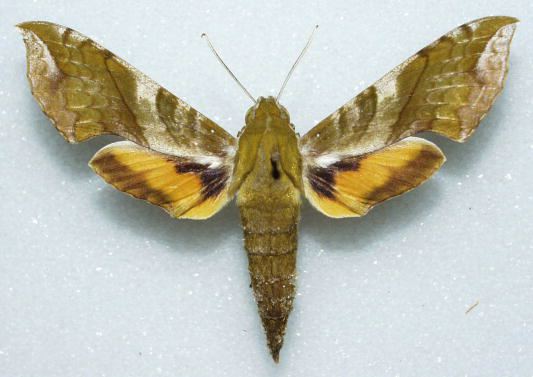
Xylophanes pluto, Mexico, courtesy of Manuel Balcazar-Lara.
This site has been created by Bill Oehlke .
Comments, suggestions and/or additional information are welcomed by Bill.
TAXONOMY:
Family: Sphingidae, Latreille, 1802 |
|
|
Updated as per
AN ANNOTATED CHECKLIST OF THE SPHINGIDAE OF BOLIVIA, October 2007 Updated as per http://www.pybio.org/SPHINGINAE.htm (Paraguay), October 2007 Updated as per More, Kitching and Cocucci's Hawkmoths of Argentina 2005, October, 2007 Updated as per personal communication with Shelby Heeter (Lower Matecumbe, Monroe County, Florida, November 17, 2008), January 2009 Updated as per personal communication with Ezequiel Nunez Bustos (Aguas Blancas, Salta, Argentina, 405m); December 2009 Updated as per personal communication with Ezequiel Nunez Bustos (Osununu Private Reserve, Misiones, Argentina, November 24, 2009); December 2009 Updated as per personal communication with Paul Hoekstra (Yucatan, Mexico, September 13, 2011); October 2, 2011 Updated as per personal communication with Ben Trott (Playa del Carmen, Quintana Roo, Mexico); February 25, 2012; January 9, 2013 Updated as per personal communication with Larry Valentine (Itanhandu, Minas Gerais, Brazil, February 8, 2013); February 9, 2013 Updated as per "A Hawk Moths fauna of southern Maranhão state, Brazil, ... "; NEVA: Jahrgang 34 Heft 3 November 2013; via Jean Haxaire; April 5, 2014 Updated as per personal communication with Elliotte Rusty Harold, (Panama, November 2011), May 18, 2014 Updated as per personal communication with Hubert Mayer, (La Union del Toachi, Pichincha, Ecuador); June 7, 2014 Updated as per personal communication with Sergio D. Ríos Díaz in CATÁLOGO DE LOS SPHINGIDAE (INSECTA: LEPIDOPTERA) DEPOSITADOS EN EL MUSEO NACIONAL DE HISTORIA NATURAL DEL PARAGUAY; sent to me in July 2014 by Sergio D. Ríos Díaz. Updated as per personal communication with Tony James (St. Lucia, October 8, 2015); November 16, 2015 Updated as per personal communication with Ezequiel Bustos (Shilap revta. lepid. 43 (172) diciembre, 2015, 615-631 eISSN 2340-4078 ISSN 0300-5267), January 4, 2016 Updated as per personal communication with Jean Haxaire, (La Vega, Dominican Republic); March 13, 2017 Updated as per personal communication with Gernot Kunz (El Copan, Cartago, Costa Rica, March 6, 2019, 1047m); April 17, 2019 |

This site has been created by Bill Oehlke .
Comments, suggestions and/or additional information are welcomed by Bill.
TAXONOMY:
Family: Sphingidae, Latreille, 1802 |
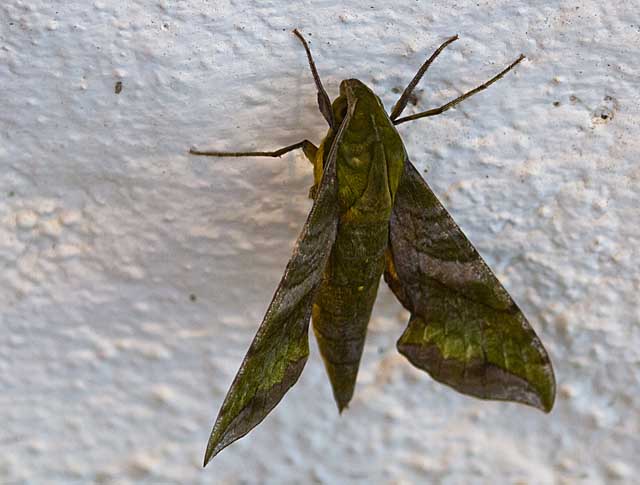
Xylophanes pluto, Canopy Lodge, El Valle de Anton, Panama,
November 2011, courtesy of Elliotte Rusty Harold.
Visit Xylophanes pluto, Anse Chastanet, Soufriere, SW St. Lucia, October 8, 2015, courtesy of Pat and Tony James.
Visit Xylophanes pluto, Lower Matecumbe, Monroe County, Florida, November 17, 2008, courtesy of Kevin and Shelby Heeter.
Visit Xylophanes pluto, Osununu Private Reserve, Misiones, Argentina, November 24, 2009, courtesy of Ezequiel Nunez Bustos.
Visit Xylophanes pluto, Yucatan, Mexico, September 13, 2011, Paul Hoekstra.
Visit Xylophanes pluto, adult, recto and verso, Itanhandu, Minas Gerais, Brazil, February 8, 2013, Larry Valentine.
Visit Xylophanes pluto moth and larva, La Vega, Dominican Republic, Jean Haxaire.
Visit Xylophnes pluto male and female, La Union del Toachi, Pichincha, Ecuador, December, 1988, Hubert Mayer.
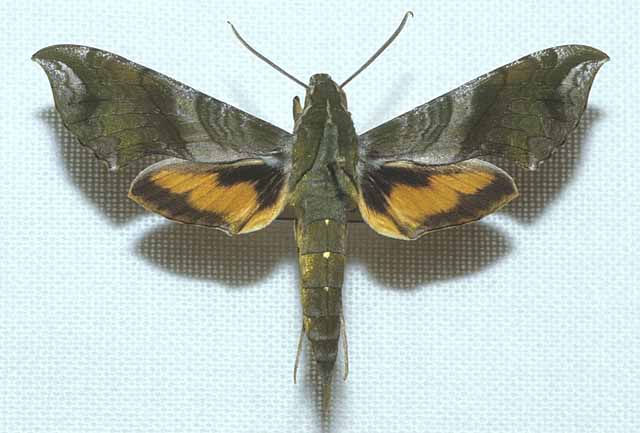
Xylophanes pluto male courtesy of Hubert Mayer copyright.
The pronunciation of scientific names is troublesome for many. The "suggestion" at the top of the page is
merely a suggestion. It is based on commonly accepted English pronunciation of Greek names and/or some
fairly well accepted "rules" for latinized scientific names.
The suggested pronunciations, on this page and on other pages, are primarily put forward to assist those who hear with internal ears as they read.
There are many collectors from different countries whose intonations and accents would be different.
Some of the early describers/namers chose genus and species names indicating some character of the insect, but more
often, they simply chose names from Greek or Roman mythology or history. Those species names which end in "ensis" indicate a
specimen locale, and those which end in "i", pronounced "eye", honour a contempory friend/collector/etc.
"Xylophanes" sounds like it is from Greek mythology, and Pluto, in Greek mythology, is the lord of Hades, the underworld.
The upperside of the forewing is olive green with a paler median band and pale lines with purple shading along them. The upperside of the hindwing has a white spot surrounded by black at the base, a wide orangish yellow median band, and a brown to greenish band along the outer margin.Xylophanes pluto in a typical resting pose to the right.
Xylophanes pluto, Boca Raton, Florida, courtesy of Alan Chin-Lee. |
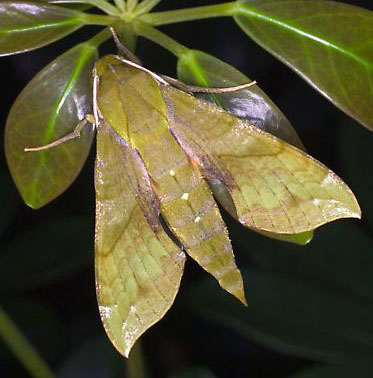 |
Sergio Rios Diaz reports March and September-December flights in Paraguay.
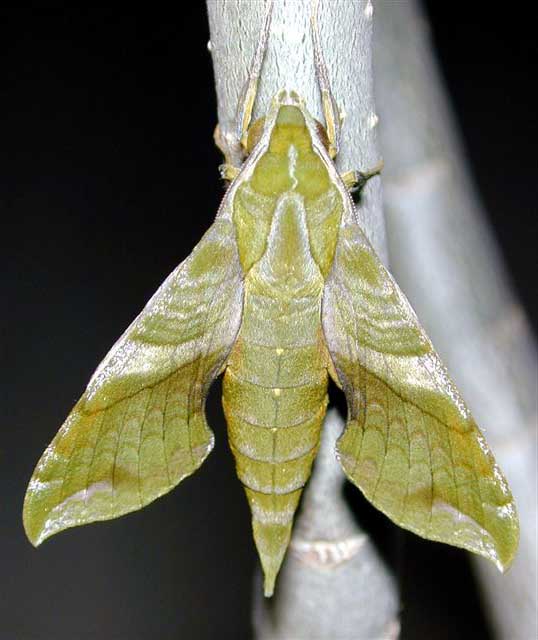
Xylophanes pluto south Texas, ex pupa, courtesy of Mike van Buskirk
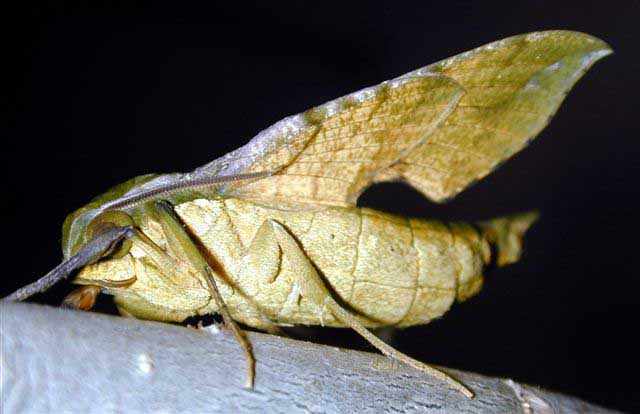
Xylophanes pluto ventral, south Texas, ex pupa, courtesy of Mike van Buskirk
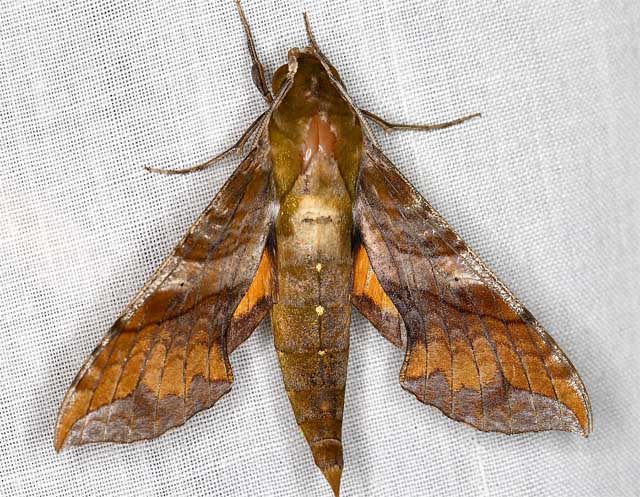
Xylophanes pluto, El Copan, Cartago, Costa Rica,
March 6, 2019, 1047m, courtesy of Gernot Kunz.
Larvae feed on Milkberry (Chiococca species), Firebush (Hamelia patens), Indian Mulberry (Morinda royoc) and Erythroxylon species. Generally larvae feed on plants in the Ruciaceae family.There are three known colour morphs: green, brown, and purple/brown. The false eyes are rather striking in this purple/brown form. Larvae feed beginning at dusk and through the night, hiding during the day at the base of their host plant or in nearby surrounding vegetation. The caterpillars usually either consume entire leaves or half of a leaf. | 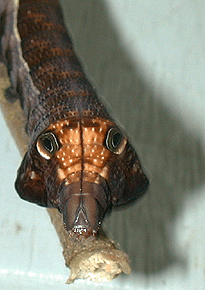 |
Visit Xylophanes pluto (green form) on firebush, Kelli Whitney, Park Naturalist II, Long Key Nature Centre, Broward County, Florida, August 30, 2009.
Pentas should be added to the foodplant list as I received these images of Xylophanes pluto feeding on pentas from Miami, Florida, December 7, 2004, courtesy of Lesli Radcliffe.
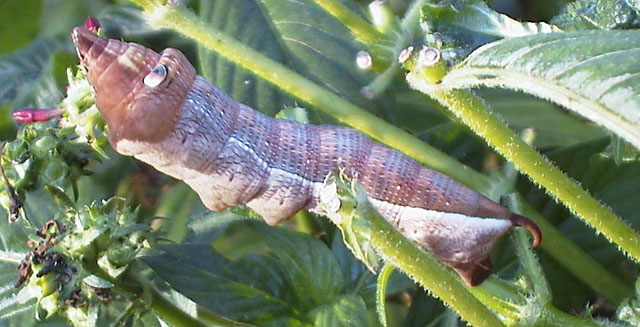
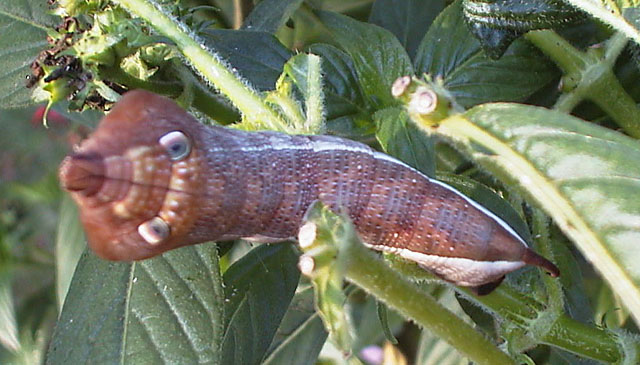
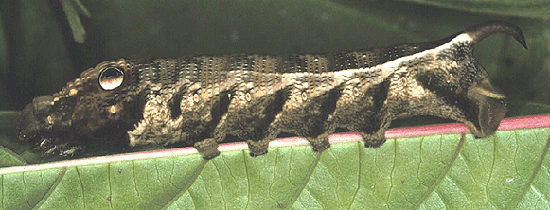
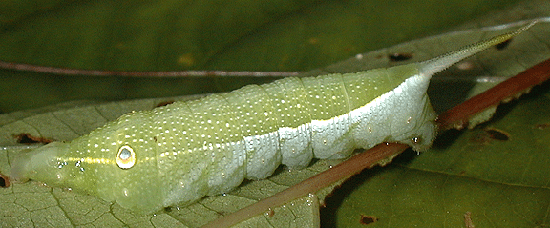
Green form in third instar.
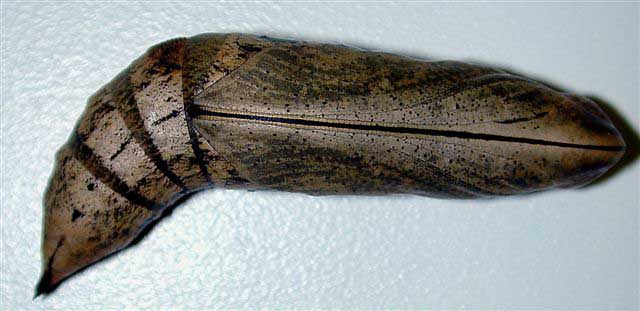
Xylophanes pluto pupa, courtesy of Mike Van Buskirk.
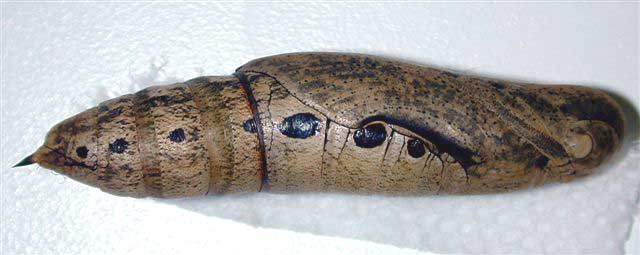
Xylophanes pluto pupa, courtesy of Mike Van Buskirk.
Parasitoids include Drino species, Belvosia species and other members of the Tachinidae family.
Visit Xylophanes pluto, from Edinburg, Hidalgo County, via Mike Quinn, courtesy of Cat Traylor.
Ben Trott sends a series of images from Playa del Carmen, Quintana Roo, Mexico.
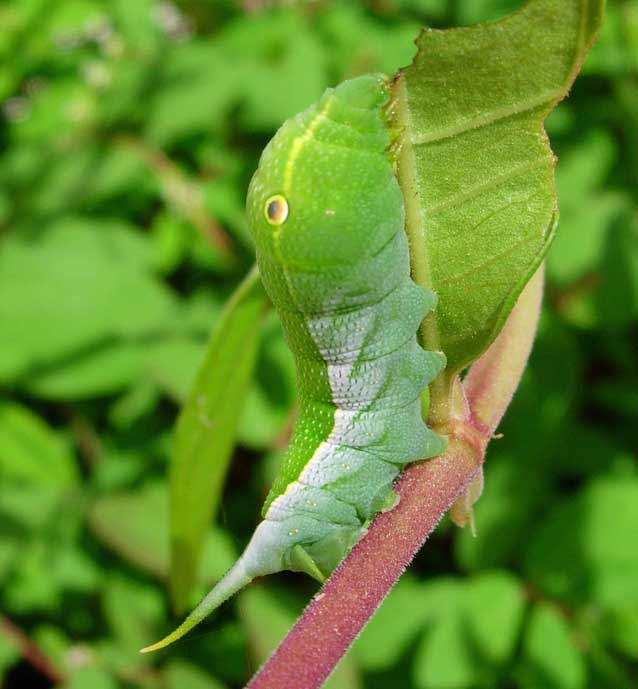
Xylophanes pluto fourth instar, Playa del Carmen, Quintana Roo, Mexico,
courtesy of Ben Trott
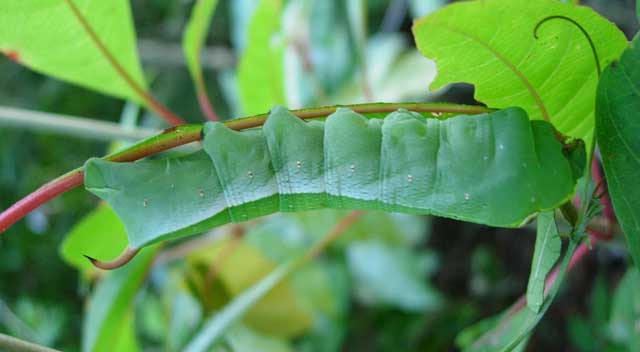
Xylophanes pluto fifth instar, Playa del Carmen, Quintana Roo, Mexico,
courtesy of Ben Trott
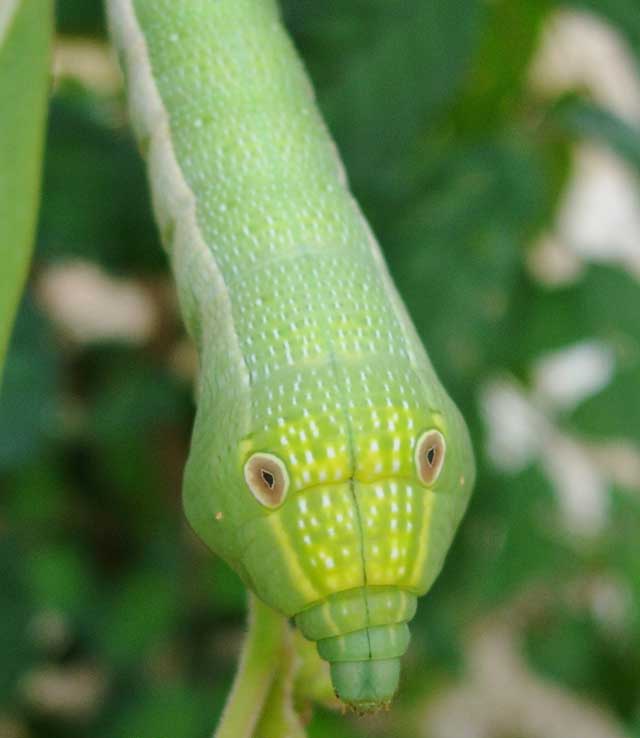
Xylophanes pluto fifth instar, Playa del Carmen, Quintana Roo, Mexico,
courtesy of Ben Trott
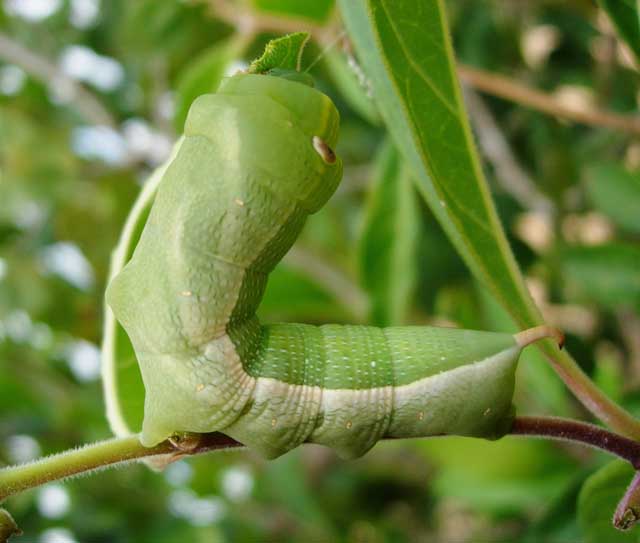
Xylophanes pluto fifth instar, Playa del Carmen, Quintana Roo, Mexico,
courtesy of Ben Trott
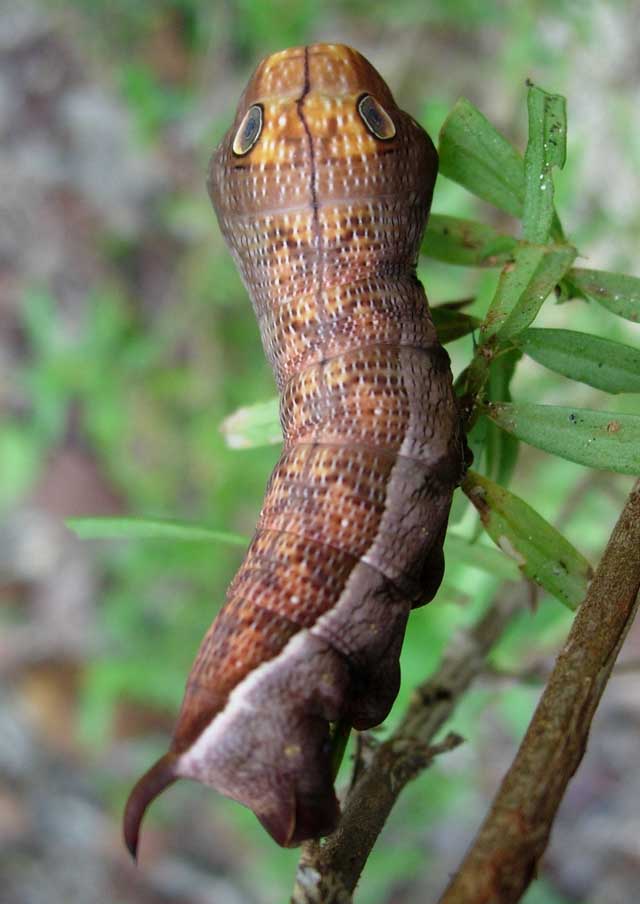
Xylophanes pluto fifth instar, Playa del Carmen, Quintana Roo, Mexico,
courtesy of Ben Trott
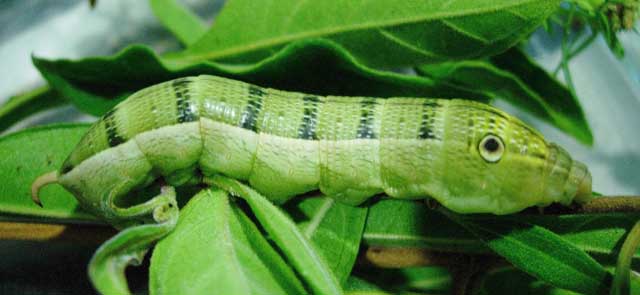
Xylophanes pluto prepupal, Playa del Carmen, Quintana Roo, Mexico,
courtesy of Ben Trott
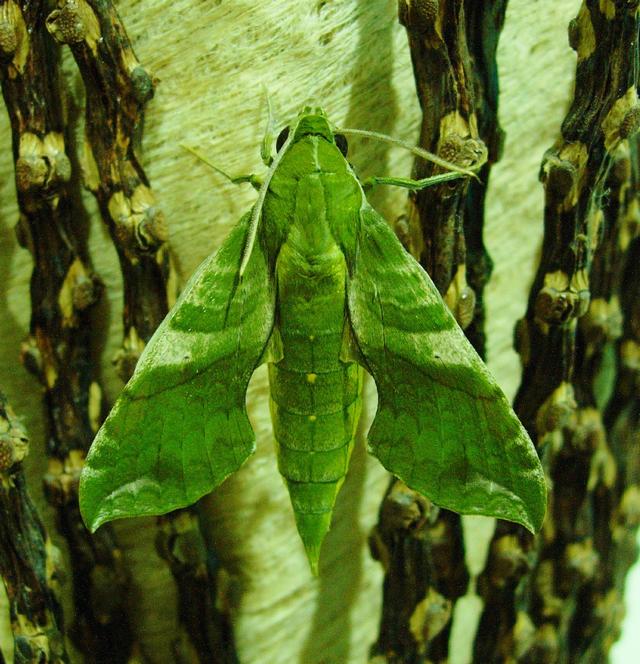
Xylophanes pluto, Playa del Carmen, Quintana Roo, Mexico,
courtesy of Ben Trott
Further observations from Ben Trott: "A couple of photos of a X. pluto female which hatched after 18 days of pupation on the 28th Dec. (same night as E. anchemolus) with a wingspan of 80mm. I've attached a photo of the 4th instar which is olive green (found on the 3rd Dec.), and the same larva in its 5th instar (orange form) which pupated around the 10th Dec (the female pupa measures 51mm). The primary hostplant for the larvae is Morinda, in the Rubiaceae family."
Use your browser "Back" button to return to the previous page.
Goto Main Sphingidae Index
Goto Macroglossini Tribe
Goto Central American Indices
Goto Carribean Islands
Goto South American Indices
Goto U.S.A. tables
Use your browser "Back" button to return to the previous page.
This page is brought to you by Bill Oehlke and the WLSS. Pages are on space rented from Bizland. If you would like to become a "Patron of the Sphingidae Site", contact Bill.
Please send sightings/images to Bill. I will do my best to respond to requests for identification help.